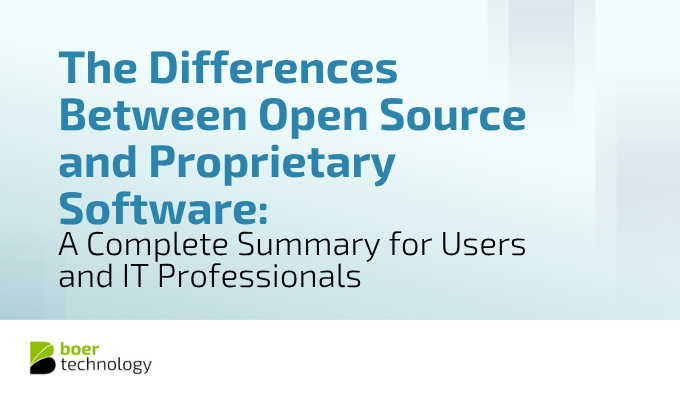the differences between Open Source and Proprietary Software: A Complete Summary for Users and IT Professionals
In today’s digital world, software is the backbone of countless activities—from operating systems and productivity tools to business platforms. Two major software models often discussed are Open Source Software (OSS) and Proprietary Software. Each has its own unique characteristics, strengths, and limitations, making them suitable for different types of users and use cases.
This article provides an in-depth and clear summary of the differences between these two software models, covering licensing, source code access, cost, support, and practical applications. Understanding these differences helps users and IT professionals choose the software that best fits their needs.
1. What Is Open Source Software?
Open Source Software refers to software whose source code is publicly accessible. Anyone can study, modify, or redistribute it under open source licenses such as GPL, MIT, or Apache.
Key characteristics include:
-
Full access to source code
Users can inspect how the software works, fix bugs, or add new features. -
High flexibility
OSS is ideal for organizations that need customized systems. -
Low or zero cost
Many open source tools are free or require minimal fees for optional support services.
Popular examples include Linux, Mozilla Firefox, WordPress, and GIMP.
2. What Is Proprietary Software?
Proprietary Software is software developed and fully controlled by an individual or company. Users are only granted the right to use the software according to a license, but cannot access or modify the source code.
Its features include:
-
Closed source code
The internal workings of the software are hidden from users. -
Paid licensing
Proprietary software typically requires subscription or one-time license fees. -
Professional support
Companies provide official support, updates, and maintenance.
Examples include Microsoft Office, Windows OS, Adobe Photoshop, and CorelDraw.
3. Key Differences Between Open Source and Proprietary Software
a. Licensing
-
Open Source:
Allows modification and redistribution within the terms of the license. -
Proprietary:
Strict licensing rules; users are only permitted to use the software as specified.
b. Source Code Access
-
OSS: Fully transparent and publicly accessible.
-
Proprietary: Completely restricted to protect commercial interests.
c. Support and Updates
-
OSS:
Often community-driven, with updates contributed by developers worldwide. -
Proprietary:
Offers structured, official support from the software company.
d. Cost
-
OSS: Free or low cost.
-
Proprietary: Generally more expensive, especially for business use.
e. Ease of Use
-
OSS: May require more technical knowledge.
-
Proprietary: Designed to be user-friendly and intuitive.
4. Advantages and Disadvantages of Both
Open Source Software
Advantages:
-
Highly transparent
-
Fully customizable
-
Cost-efficient
-
Backed by an active global community
Disadvantages:
-
May lack official technical support
-
Can be challenging for beginners
-
Some open source projects offer fewer features compared to commercial software
Proprietary Software
Advantages:
-
Professional customer support
-
User-friendly interface
-
Security maintained by the company
-
More stable with regular updates
Disadvantages:
-
Higher cost
-
No ability to modify or customize internally
-
Creates dependency on the vendor (vendor lock-in)
5. Which Should You Choose?
The right choice depends on your needs:
Choose Open Source if you:
-
Need high flexibility
-
Have a limited budget
-
Want the ability to customize and modify the software
-
Prefer transparency and full control
OSS is ideal for developers, startups, students, and organizations that prioritize cost efficiency.
Choose Proprietary Software if you:
-
Need professional technical support
-
Prefer convenience and ease of use
-
Work in environments requiring standardized tools
-
Don’t need to modify the software internally
Proprietary software is often the best fit for large businesses, design professionals, and general users seeking maximum convenience.
6. Conclusion
Both Open Source and Proprietary Software play crucial roles in the modern technology landscape. Open Source provides freedom, cost efficiency, and customization opportunities, making it perfect for users who want control and flexibility. Meanwhile, Proprietary Software excels in user-friendliness, managed security, and official support.
By understanding the differences between the two, users and IT professionals can make informed decisions that align with their operational needs and long-term goals.
Unlock The Full Potential of Open Source Software
Looking to modernize your IT infrastructure with the power and flexibility of open-source technology? Our Cloud Managed Services deliver fully optimized, secure, and scalable solutions built on trusted open-source platforms. We handle everything—from deployment and monitoring to maintenance and performance tuning—so your team can focus on innovation instead of operations. Let us help you reduce costs, eliminate vendor lock-in, and accelerate your digital transformation with reliable open-source cloud solutions tailored to your business needs. Ready to get started? Partner with us today and unlock the full potential of open-source in the cloud.
contact@btech.id / +62-811-1123-242

